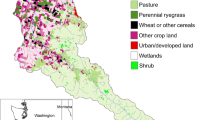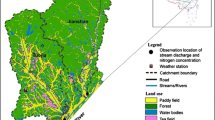Abstract
The nitrogen (N) budget calculation approach is a useful means of evaluating the impact of human activity on the N cycle. Field scale N budget calculations may ignore the interactions between landscapes, and regional scale calculations rely on statistical data and indirect parameters. Watershed scale budget calculations allow for a more direct quantification of N inputs and outputs. We conducted N budget calculations for a rice paddy-dominated agricultural watershed in eastern China for 2007–2009, based on intensive monitoring of stream N dynamics, atmospheric deposition, ammonia (NH3) volatilization and household interviews about N-related agricultural activities. The results showed that although total N input to the watershed was up to 280 kg N ha−1 year−1, riverine discharge was only 4.2 kg N ha−1 year−1, accounting for 1.5% of the total N input, and was further reduced to 2.0 kg N ha−1 year−1 after reservoir storage and/or denitrification removal. The low riverine N output was because of the characteristics of the rice paddy-dominated landscape, which intercepts run-off and enhances soil denitrification. The watershed actually purified the N in rainwater, as N concentrations in river discharge were much lower than those in rain water. Major N outputs included food/feed export, NH3 volatilization from chemical fertilizer and manure, and emissions from crop residue burning. Net reactive gaseous emissions (emissions minus deposition) accounted for 5.5% of the total N input, much higher than riverine discharge. Therefore, the agricultural N cycle in such paddy-dominated watersheds impacts the environment mainly through gas exchange rather than water discharge.









Similar content being viewed by others
Abbreviations
- NANI:
-
Net anthropogenic nitrogen input
- N:
-
Nitrogen
- TN:
-
Total dissolved nitrogen
References
Andreae MO, Merlet P (2001) Emission of trace gases and aerosols from biomass burning. Global Biogeochem Cycles 15:955–966
Boyer EW, Goodale CL, Jaworsk NA, Howarth RW (2002) Anthropogenic nitrogen sources and relationships to riverine nitrogen export in the northeastern USA. Biogeochemistry 57:137–169
Burns RC, Hardy RWF (1975) Nitrogen fixation in bacteria and higher plants. Springer-Verlag, New York
Cai GX, Yang LC, Lu WF, Chen W, Xia BQ, Wang XZ, Zhu ZL (1992) Gaseous loss of nitrogen from fertilizers applied to a paddy soil in southeastern China. Pedosphere 2:209–217
David MB, Gentry LE, Kovacic DA, Smith KM (1997) Nitrogen balance in and export from an agricultural watershed. J Environ Qual 26:1038–1048
Deng MH, Xie YX, Xiong ZQ, Xing GX, Yan XY (2007) Nitrogen budgets of the Yangtse delta region and their effect on the environment. Acta Sci Circumst 27:1709–1716 (in Chinese)
Dong WX, Hu CS, Zhang YM (2006) In situ determination ammonia volatilization in field of North China. Chin J Eco-Agri 14:46–48 (in Chinese)
FAO (2008) FAOSTAT agriculture data [Online] http://apps.fao.org/page/collections?subset=agriculture
Galloway JN, Dentener FJ, Capone DG, Boyer EW, Howarth RW, Seitzinger SP, Asner GP, Cleveland CC, Green PA, Holland EA, Karl DM, Michaels AF, Porter JH, Townsend AR, Vorosmarty CJ (2004) Nitrogen cycles: past, present, and future. Biogeochemistry 70:153–226
Gentry LE, David MB, Below FE, Royer TV, McLsaac GF (2009) Nitrogen mass balance of a tile-drained agricultural watershed in East-Central Illinois. J Environ Qual 38:1841–1847
Giles J (2005) Nitrogen study fertilizes fears of pollution. Nature 433:791
Groffman PM, Altabet MA, Bohlke JK, Butterbach-Bahl K, David MB, Firestone MK, Giblin AE, Kana TM, Nielsen LP, Voytek MA (2006) Methods for measuring denitrification: diverse approaches to a difficult problem. Ecol Appl 16:2091–2122
Howarth RW, Billen G, Swaney D, Townsend A, Jaworski N, Lajtha K, Downing JA, Elmgren R, Caraco N, Jordan T, Berendse F, Freney J, Kudeyarov V, Murdoch P, Zhu ZL (1996) Regional nitrogen budgets and riverine N&P fluxes for the drainages to the North Atlantic Ocean: natural and human influences. Biogeochemistry 35:75–139
Howarth RW, Swaney DP, Boyer EW, Marino R, Jaworski N, Goodale C (2006) The influence of climate on average nitrogen export from large watersheds in the Northeastern United States. Biogeochemistry 79:163–186
Intergovernmental Panel on Climate Change (IPCC) (2007) 2006 IPCC Guidelines for national greenhouse gas inventories. Institute for Global Environmental Strategies, Hayama, Japan
Ju XT, Xing GX, Chen XP, Zhang SL, Zhang LJ, Liu XJ, Cui ZL, Yin B, Christie P, Zhu ZL, Zhang FS (2009) Reducing environmental risk by improving N management in intensive Chinese agricultural systems. In: Proc of the Nat Acad sci 106:3041–3046
Knowles R (1990) Acetylene inhibition technique: development, advantages and potential problems. Plenum Press, New York
Konohira E, Yoh M, Kubota J, Yagi K, Akiyama H (2001) Effects of riparian denitrification on stream nitrate—evidence from isotope analysis and extreme nitrate leaching during rainfall. Water Air Soil Pollut 130:667–672
Li FY, Yng R, Ti CP, Mang L, Kimura SK, Yan XY (2010) Denitrification characteristics of pond sediments in a Chinese agricultural watershed. Soil Sci Plant Nutr 56:66–71
Liang XQ, Chen YX, Li H, Tian GM, Ni WZ, He MM, Zhang ZJ (2007) Modeling transport and fate of nitrogen from urea applied to a near-trench paddy field. Environ Pollut 150:313–320
Lowrance R (1992) Nitrogen outputs from a field-size agricultural watershed. J Environ Qual 21:602–607
McIsaac GF, Hu XT (2004) Net N input and riverine N export from Illinois agricultural watersheds with and without extensive tile drainage. Biogeochemistry 70:251–271
Qin BQ, Xu PZ, Wu QL, Luo LC, Zhang YL (2007) Environmental issues of Lake Taihu, China. Hydrobiologia 581:3–14
Schaefer SC, Alber M (2007) Temperature controls a latitudinal gradient in the proportion of watershed nitrogen exported to coastal ecosystems. Biogeochemistry 85:333–346
Schaefer SC, Hollibaugh JT, Alber M (2009) Watershed nitrogen input and riverine export on the west coast of the US. Biogeochemistry 93:219–233
Shen ZL, Liu Q, Zhang SM (2003) Distribution, variation and removal patterns of total nitrogen and organic nitrogen in the Changjiang River. Oceanol Limnol Sin 34:577–585 (in Chinese)
Sobota DJ, Harrison JA, Dahlgren RA (2009) Influences of climate, hydrology, and land use on input and export of nitrogen in California watersheds. Biogeochemistry 94:43–62
Su H, Zhu B, Yan XY, Yang R (2009) Numerical simulation for dry deposition of ammonia and nitrogen dioxide in a small watershed in Jurong county of Jiangsu province. Chin J Agrometerol 30:335–342 (in Chinese)
Tian GM, Cai ZC, Cao JL, Li XP (2001) Factors affecting ammonia volatilisation from a rice–wheat rotation system. Chemosphere 42:123–129
Tian YH, Yin B, Yang LZ, Yin SX, Zhu ZL (2007) Nitrogen runoff and leaching losses during rice–wheat rotations in Taihu Lake region, China. Pedosphere 17:445–456
Ventura M, Scandellari F, Ventura F, Guzzon B, Pisa PR, Tagliavini M (2008) Nitrogen balance and losses through drainage waters in an agricultural watershed of the Po Valley (Italy). Eur J Agron 29:108–115
Vitousek PM, Aber JD, Howarth RW, Likens GE, Matson PA, Schindler DW, Schlesinger WH, Tilman GD (1997) Human alteration of the global nitrogen cycle: sources and consequences. Ecol Appl 7:737–750
Wang XZ, Zhu JG, Gao R, Yasukazu H, Feng K (2007) Nitrogen cycling and losses under rice–wheat rotations with coated urea and urea in the Taihu Lake region. Pedosphere 17:62–69
Wu JX, Cheng X, Xiao HS, Wang HQ, Yang LZ, Ellis EC (2009) Agricultural landscape change in China’s Yangtze Delta, 1942–2002: a case study. Agric Ecosyst Environ 129:523–533
Xing GX, Yan XY (1999) Direct nitrous oxide emissions from agricultural fields in China estimated by the revised 1996 IPCC guidelines for national greenhouse gases. Environ Sci Policy 2:355–361
Xing GX, Zhu ZL (2002) Regional nitrogen budgets for China and its major watersheds. Biogeochemistry 57:405–427
Xing GX, Cao YC, Shi SL, Sun GQ, Du LJ, Zhu JG (2002) Denitrification in underground saturated soil in a rice paddy region. Soil Biol Biochem 34:1593–1598
Yan WJ, Yin CQ, Tang HX (1998) Nutrient retention by multipond systems: mechanisms for the control of nonpoint source pollution. J Environ Qual 27:1009–1017
Yoshikawa N, Shiozawa S, Ardiansyah (2008) Nitrogen budget and gaseous nitrogen loss in a tropical agricultural watershed. Biogeochemistry 87:1–15
Zhang YG, Zhou ML, Wu XG (1986) Soils in Jurong country, Jiangsu province. Internal materials. (in Chinese)
Zhao X, Yan XY, Xiong ZQ, Xie YX, Xing GX, Shi SL, Zhu ZL (2009) Spatial and temporal variation of inorganic nitrogen wet deposition to the Yangtze River Delta region, China. Water Air Soil Pollut 203:277–289
Zhu ZL (1997) Nitrogen balance and cycling in agroecosystems of China. In: Zhu ZL, Wen QX, Freney JR (eds) Nitrogen in Soils of China. Kluwer, Dordrecht, pp 323–338
Zhu ZL, Chen DL (2002) Nitrogen fertilizer use in China—contributions to food production, impacts on the environment and best management strategies. Nutr Cycl Agroecosyst 63:117–127
Zou JW, Huang Y, Lu YY, Zheng XH, Wang YS (2005) Direct emission factor for N2O from rice–winter wheat rotation systems in southeast China. Atmos Environ 39:4755–4765
Acknowledgments
This study was financed by Knowledge Innovation Program of the Chinese Academy of Science (No. KZCX2-YW-GJ01) and the National Natural Science Foundation of China (No. 40721140018, 41071196).
Author information
Authors and Affiliations
Corresponding author
Rights and permissions
About this article
Cite this article
Yan, X., Cai, Z., Yang, R. et al. Nitrogen budget and riverine nitrogen output in a rice paddy dominated agricultural watershed in eastern China. Biogeochemistry 106, 489–501 (2011). https://doi.org/10.1007/s10533-010-9528-0
Received:
Accepted:
Published:
Issue Date:
DOI: https://doi.org/10.1007/s10533-010-9528-0




